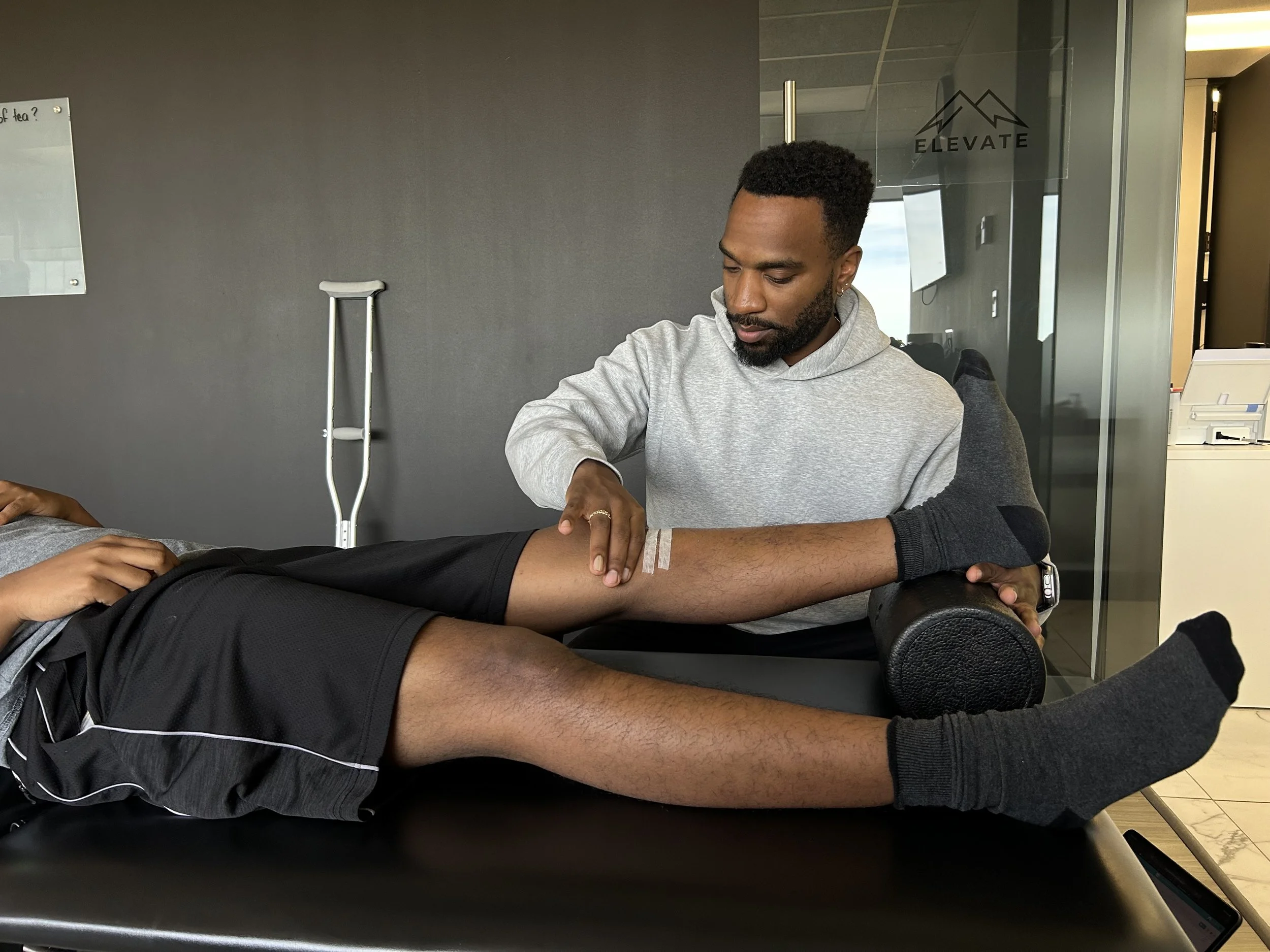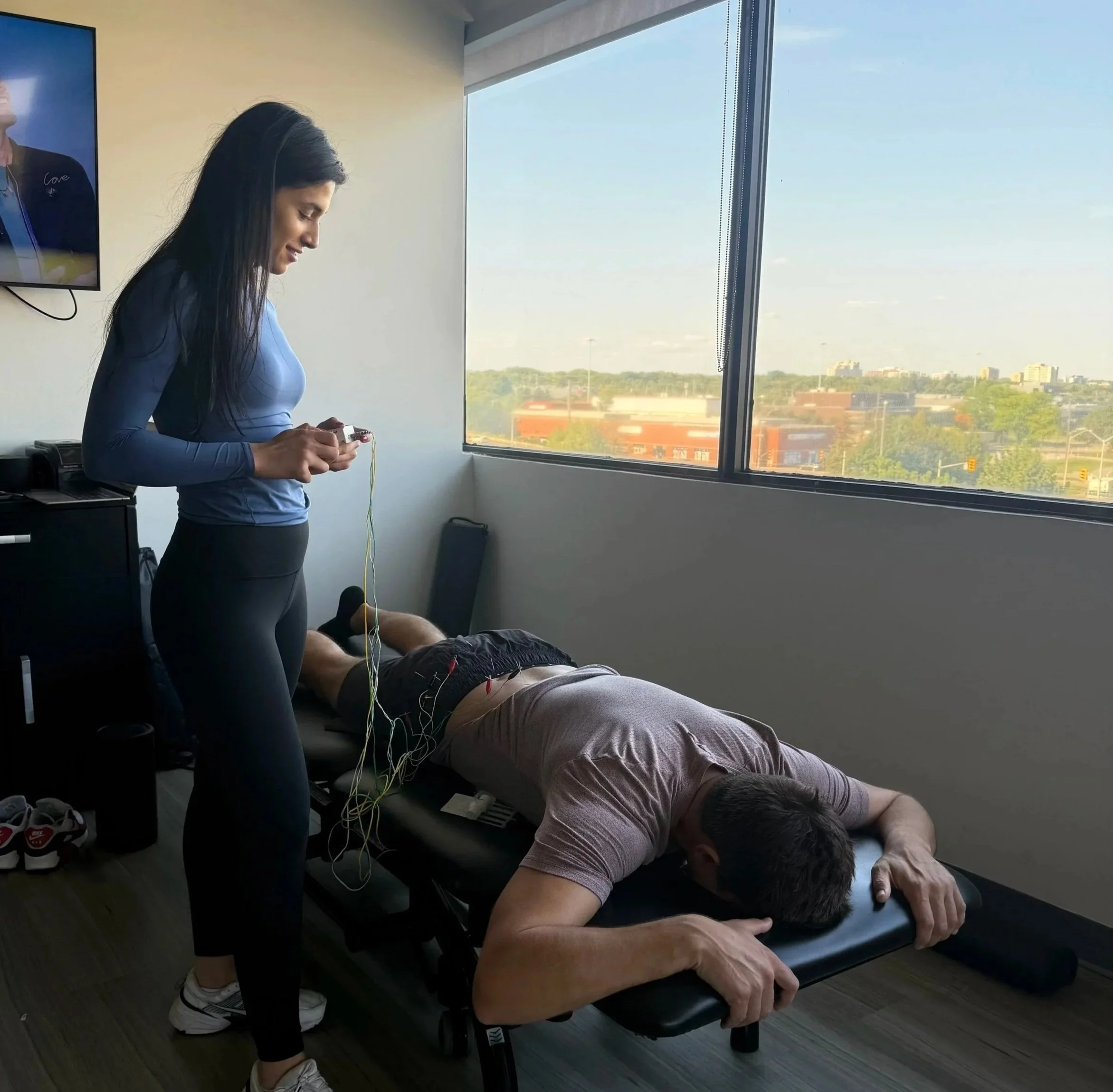The Ultimate Guide to ACL Recovery
An ACL tear can feel like a major setback, especially for athletes and active adults. But it doesn’t have to feel like the end of the road. Whether you’re recovering from surgery or pursuing a non-operative route, understanding the ACL rehab process is crucial to getting the best possible outcome.
This ultimate guide combines expert insights from our practitioners, practical tips, and a full roadmap of what to expect at each phase of your journey. Follow the helpful links to our in-depth ACL articles if you are interested in exploring any topics further. You’ll have a complete set of resources you can return to whenever you need support or direction.
At Elevate Rehabilitation and Performance in Oakville, we’ve helped everyone from high-level athletes to weekend warriors recover from ACL injuries and return stronger. Let’s walk through the full recovery process and show you how to stay consistent, avoid common setbacks, and take advantage of the latest tools in sports rehab.
Understanding the ACL: Its Role and Importance in Movement
The anterior cruciate ligament (ACL) is one of the four major ligaments in the knee, and plays a significant role in maintaining joint stability. It helps resist excessive forward movement of the tibia relative to the femur, and it provides rotational control when performing high-speed movements like cutting, jumping, and pivoting.
ACL injuries commonly occur in sports that involve sudden stops and directional changes, like soccer, basketball, skiing, and football. Once torn, the ACL does not heal on its own. Surgical reconstruction or a comprehensive non-surgical rehab plan is typically required for a full return to sports or active living.
Without proper rehab, ACL injuries can lead to long-term issues such as instability, early osteoarthritis, and re-injury. That’s why a structured and science-based approach to recovery is so important.
ACL Graft Types: Which One Is Right for You?
If you’re having surgery to reconstruct your ACL, one decision you’ll have to make with your surgeon is the type of graft to use. The graft is the new tissue that replaces your torn ligament, and the type can affect healing time, rehab needs, and long-term outcomes.
Here are the most common ACL graft options:
Patellar Tendon Graft
Hamstring Tendon Graft
Quadriceps Tendon Graft
Allograft (Donor Tissue)
Dive deeper into how these may change your recovery path by reading our blog ACL Surgery Grafts: What’s the Difference and How Does it Change Your Rehab?
The Foundation of Recovery: Phase One and the First Few Weeks
The early stages of ACL rehab focus on reducing inflammation, restoring mobility, and reactivating the quadriceps muscles. Swelling and muscle inhibition can prevent you from walking normally or regaining full range of motion.
These initial goals are the foundation for all future progress. Gentle manual therapy, early mobility exercises, neuromuscular re-education, and pain management are key components.
For a detailed breakdown of this phase, visit our blog ACL Rehab Timeline: What to Expect Week by Week.
A State-of-the-Art Way to Rehab
Our clinic utilizes advanced tools like the Anti-Gravity Treadmill which allows patients to begin walking and lightly jogging before their bodyweight would normally permit it. The treadmill will reduce the user’s body weight up to 80%, minimizing impact on the lower body, but most importantly the ACL.
The Anti-Gravity Treadmill measures the user’s gait, weight distribution, and even shows a live camera angle of the lower body to help visualize movement patterns. What normally can’t be done after surgery is now achievable, allowing for a faster and smoother recovery.
Our blog Why the Anti-Gravity Treadmill Speeds up ACL Recovery will tell you all about this state-of-the-art treadmill that can get you moving early on in your recovery.
Tracking Your Progress: Are You Where You Should Be?
As your rehab progresses, it’s important to monitor your functional improvements, not only your symptoms. Pain reduction is only one marker of recovery: strength, balance, coordination, and psychological readiness matter just as much.
It’s important to note that no ACL recovery is like another, therefore you may feel slightly different throughout compared to the “normal”. That being said, following general guidelines and milestones are important to stay on track.
Our blog Signs Your ACL Recovery is On Track (Or Not) outlines key checkpoints and red flags to help you and our team determine if you’re progressing appropriately or need to adjust your plan.
Why Local, Integrated Care Matters in Oakville
Choosing a local clinic offers more than just convenience. It offers continuity, accountability, and accessibility, three pillars that are essential for success in ACL rehab.
At Elevate, our integrated care model means your Athletic Therapist, Chiropractor, Physiotherapist, and Massage Therapist are collaborating on your recovery. We customize your plan based on your sport, your schedule, and your goals.
We are a close-knit family, and you will feel that during your recovery here. Our goal is to give you an exceptional experience through our multidisciplinary approach. Your rehab matters to us, and we are all on this journey together!
See ACL Rehab in Oakville: Why Choosing the Right Clinic Matters to learn more about the benefits of receiving care in your own community.
Multidisciplinary Rehab: Why One Approach Isn’t Enough
ACL rehab isn’t a one-size-fits-all protocol. It requires expertise across multiple disciplines to restore mobility, strength, and sport-specific skills.
How Athletic Therapy Supports Your ACL Rehab Journey: Learn how athletic therapists guide movement, rebuild functional strength, and coach you back into sport.
The Role of Massage Therapy in ACL Recovery: Discover how manual therapy can relieve post-surgical tightness, improve circulation, and support tissue healing.
Chiropractic and ACL Rehab: Supporting Your Whole-Body Recovery: See how chiropractic care addresses compensations, spinal alignment, and lower limb mechanics that influence knee health.
These treatments are essential to maximize recovery and for returning back stronger than before. Taking a multidisciplinary approach allows for better recovery of your ACL, as well as your whole body.
Avoiding Setbacks: Common Mistakes and How to Stay Motivated
Many ACL rehab patients struggle with motivation, especially during long plateaus. Others unknowingly rush through phases, risking re-injury. It’s important to understand the process in order to recognize when mistakes are being made.
During your ACL recovery journey, you may find yourself falling into these traps:
Giving up mentally
Not doing at-home exercises
Comparing to other people’s ACL journeys
Neglecting knee extension
Ignoring pain signals
Recognizing these patterns is the key to preventing a delayed recovery.
Our blog ACL Rehab Mistakes to Avoid (And How to Stay Motivated) outlines these common pitfalls, and expands on their importance. We also include strategies to stay mentally engaged, like tracking wins, visualizing success, and leaning into your support system.
Women and ACL Recovery: What’s Different and What to Watch For
Female athletes experience ACL injuries at a higher rate than males, which can be attributed to a variety of biomechanical and hormonal factors. Understanding these risk factors is essential for reducing injury risk while setting yourself up for maximum performance through optimized training.
Biomechanical Factors
These tend to include structural differences in females, leading to changes in movement patterns:
Wider pelvis/larger Q-angle
Knee collapse/valgus
Quad-dominant muscle activation
Limited knee flexion during sport
Hormonal Factors
Menstrual cycle phases alter ligament laxity throughout the body, resulting in increased stretching on ligaments such as the ACL. This means we should have different recovery considerations depending on cycle phases:
Follicular Phase: Higher estrogen levels, more laxity on ligaments
Luteal Phase: Higher progesterone levels, higher reports of fatigue and joint discomfort
For more insight, our blog Women and ACL Injuries: What You Should Know About Recovery explores the unique rehab needs of women and provides strategies for optimizing recovery at every stage.
Knowing When You’re Ready: The Return-to-Sport Checklist
Returning to play is not only about how your knee feels, objective performance benchmarks and psychological readiness are important to keep in mind. Skipping this step is one of the most common causes of re-injury.
Our Athletic Therapists are experts in return-to-play assessment and are dedicated to helping you get back to your sport at 100%. We ensure you are physically and mentally ready to play to reduce your risk of reinjury.
Creating a checklist is a great objective measure to collaborate with your practitioner on. This will help keep you confident when you return-to-play, and can be used every time you are going to play your sport.
Returning to Sport After ACL Surgery: A Checklist helps you assess readiness across strength, balance, hop testing, symmetry, and sport-specific drills. It’s one of the most important reads in this series.
Planning for the Long Term: Keeping Your Knee Healthy for Life
Many people think ACL rehab ends once you’re cleared by your surgeon or therapist. However, the risk of re-injury remains high for 12-24 months. If you’ve followed your rehabilitation plan properly, you should be in the end stages of rehab at this point, and therefore are doing more complex movements.
Striking the right balance between exercise and rest is essential. It allows your body to recover fully, reduces the risk of re-injury, and helps prevent overuse issues that can arise from pushing too hard, too soon. Keep these points in mind to stay injury-free:
Resistance Training: Important for building strength around the knee joint
Neuromuscular Training: Properly learning how to land, pivot, and accelerate
Listening to Your Body: Our bodies tell us when we are overworked
Our blog Preventing Re-Injury: ACL Rehab Tips for Long-Term Knee Health outlines how to maintain strength, monitor movement patterns, and include prehab work in your regular routine to reduce future risks.
Book Smart. Rehab Smarter. Perform Your Best.
Whether your injury happened on the field, during a workout, or in a moment you never expected, the recovery process can feel overwhelming. The setbacks, the small wins, the uncertainty, and the progress are all part of the path. But here’s the good news: with a strong plan, a supportive team, and the right mindset, coming back stronger is absolutely possible.
At Elevate, we understand what it takes to help athletes rebuild from the ground up. Our approach goes far beyond basic rehab. We combine sports medicine expertise, advanced rehab technology, and an experienced, collaborative team to give you every possible advantage. We approach ACL recovery like the high-performance process it truly is because that's what you deserve.
Every step of your care is personalized. From early-stage recovery to full return-to-sport, we tailor your plan to your needs. Whether you’re using our AlterG Anti-Gravity Treadmill to reduce load during gait training or working through sport-specific exercises in your one-on-one rehab sessions, you’ll have the support of a tightly integrated team of Athletic Therapists, Physiotherapists, and Chiropractors who stay connected and aligned in your care.
Most importantly, we believe in treating the whole athlete. That means helping you move better, feel stronger, and return to your sport or lifestyle without hesitation. Whether your goals involve playing competitively, training confidently, or running around the backyard with your kids, we’re here to help you get there.
Ready to Take the Next Step?
Book a discovery session with our team so we can learn more about where you’re at, walk you through what’s possible, and show you how we can support you every step of the way.
If you’re still gathering information, we’ve linked several helpful blogs and resources above to help you build your knowledge and prepare for what’s ahead.
Wherever you are in your ACL journey, whether you're pre-op, post-op, or working toward your return, know that you do not have to navigate it alone. You’ve got a dedicated team here at Elevate, ready to help you move forward with clarity, confidence, and care.
📍 710 Dorval Dr Unit 520, Oakville, ON
📞 (289) 835-2949
💻 https://www.elevaterehabilitation.com/


